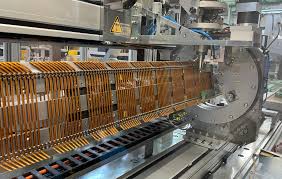From Concept to Creation: How Hairpin Making Machines Transform Production

In a world where precision meets creativity, the humble hairpin has taken center stage in an unexpected revolution. Gone are the days of manual crafting; today, we’re diving into the fascinating realm of hairpin making machines that are reshaping production processes like never before. Imagine a factory floor buzzing with innovation as these cutting-edge machines transform raw materials into perfectly crafted accessories in record time. But it’s not just about speed—these marvels of engineering blend efficiency with artistry, ensuring each piece is both functional and stylish. Join us as we explore how technology is breathing new life into an age-old concept, turning simple ideas into exquisite creations and setting the stage for a brighter future in manufacturing!
Introduction to Hairpin Making Machines
Hairpins may seem like a simple accessory, but the machines that create them are anything but ordinary. In an industry where precision and efficiency are paramount, hairpin making machines stand out as true game-changers. These remarkable pieces of technology have transformed how manufacturers produce one of the most common yet essential items in fashion and hairstyling.
Imagine a world where every hairpin is crafted with perfect symmetry and strength, all while maintaining high production speeds. That’s the power of modern hairpin making machinery at work. From their inception to today’s advanced models, these machines have evolved significantly, shaping not only products but also entire manufacturing processes.
Join us on this journey through the fascinating evolution of hair pin making machine discover their history, advantages, types, workings, and more! Whether you’re a manufacturer looking to optimize your operations or simply curious about this niche technology’s impact on production trends, there’s something here for everyone interested in the art behind creating those small yet mighty accessories we often take for granted.
History of Hairpin Making Machines
The journey of hairpin making machines traces back to the late 19th century. Initially, hairpins were crafted manually, requiring skilled artisans. The demand for these decorative accessories surged with fashion trends.
As industrialization took hold, inventors sought ways to streamline production. Early machines emerged that utilized simple mechanisms to mass-produce hairpins efficiently.
By the mid-20th century, advancements in technology brought more sophisticated designs. Automatic and semi-automatic machines began transforming how hairpins were manufactured.
These innovations not only improved speed but also enhanced precision. Factories could now produce consistent quality at a fraction of the time previously required.
Today’s modern hairpin making machines are marvels of engineering. They blend robotics and computer technology, enabling high-volume production while reducing waste significantly. Each evolution has paved the way for increased efficiency in an ever-evolving market.
Advantages of Using Hairpin Making Machines
Hairpin making machines bring a range of benefits that can significantly enhance production efficiency. One major advantage is their speed. These machines can produce hairpins at a much faster rate than manual processes, saving time and increasing output.
Consistency is another key benefit. Automated machinery ensures each hairpin meets the same quality standards, reducing defects and waste.
Cost-effectiveness also plays a crucial role. By streamlining production, businesses can lower labor costs while maximizing profits.
Additionally, modern hairpin making machines often feature programmable settings. This allows manufacturers to easily switch between different designs or sizes without extensive downtime.
Finally, these machines are designed with user-friendly interfaces that simplify operation and maintenance, enabling even those with minimal experience to operate them effectively.
Types of Hairpin Making Machines
Hairpin making machines come in various types, each designed for specific production needs. The manual hairpin machine is ideal for smaller operations. It allows artisans to create unique designs with hands-on control.
Then there’s the semi-automatic variety, which boosts efficiency while still giving operators some flexibility in design choices. This type strikes a balance between craftsmanship and productivity.
For high-volume demands, fully automatic hairpin making machines are the go-to option. These powerhouses can churn out thousands of pieces with minimal human intervention.
Additionally, specialized machines cater to different styles—such as decorative or functional hairpins—ensuring that manufacturers meet diverse market trends effectively. Each machine type plays a vital role in shaping how businesses approach their production processes.
Hairpin making machines operate with precision and efficiency. They begin by feeding raw wire into the machine, which is then cut to specific lengths based on design requirements.
Once cut, the wire undergoes bending processes facilitated by a series of automated mechanisms. These components work in unison to shape the wire into hairpins or clips while ensuring uniformity across each piece.
Next comes the fastening stage, where ends are secured either through welding or other fastening methods. This step is crucial for durability and reliability in finished products.
Advanced models integrate computer numerical control (CNC) technology for enhanced accuracy. Operators can input specifications easily, allowing for quick adjustments between different designs.
Finally, quality checks are performed automatically as items exit the machine. This ensures that every hairpin meets industry standards before packaging and distribution.
Key Components and Features of Hairpin Making Machines
Hairpin making machines are engineered with several key components that enhance their functionality. At the core is the feeding mechanism, which ensures precise delivery of raw materials for consistent production.
The forming unit shapes wires into hairpins with utmost accuracy. Advanced models feature programmable controls, allowing operators to set specific dimensions and styles quickly.
Another crucial component is the cutting system. It guarantees clean cuts at desired lengths, minimizing waste and maximizing efficiency.
Additionally, many machines incorporate safety features like emergency stop buttons and guards to protect workers during operation.
User-friendly interfaces streamline monitoring processes, enabling quick adjustments on-the-fly.
Moreover, some modern machines come equipped with data tracking systems that offer insights into production rates and machine performance over time. These innovations contribute significantly to productivity in manufacturing environments while ensuring high-quality output.
Factors to Consider when Choosing a Hairpin Making Machine
Selecting the right hairpin making machine involves several crucial factors. First, consider production capacity. Assess your volume needs to ensure efficiency meets demand.
Next, evaluate the machine’s precision. High-quality machines offer better accuracy, resulting in consistent product quality. This can impact customer satisfaction and brand reputation.
Material compatibility is another essential factor. Ensure the machine can handle the types of wire or materials you plan to use for optimal results.
Ease of operation also matters greatly. Look for user-friendly interfaces and control systems that minimize training time for operators.
Finally, don’t forget about support and maintenance options. A reliable service provider can make a significant difference in minimizing downtime and maximizing productivity over time.
Maintenance and Troubleshooting Tips for Hairpin Making Machines
Regular maintenance is key to keeping your hairpin making machine running smoothly. Schedule routine inspections to check for wear and tear on critical components. Lubricate moving parts as recommended by the manufacturer. This helps reduce friction and prolongs lifespan.
Keep the work area clean. Residue can affect performance, causing jams or misalignments in production. A tidy space ensures that you notice any potential issues before they escalate.
If problems arise, consult your troubleshooting guide first. Common issues might include inconsistent wire feeding or irregular bends in the hairpins. Adjust tension settings if you notice these anomalies.
Don’t ignore strange noises during operation; they could signal a mechanical problem needing immediate attention. Addressing minor glitches promptly saves time and prevents costly repairs down the line.
Lastly, maintain a log of all maintenance activities and repairs performed on your machine for better tracking over time.
Innovations and Future Developments in Hairpin Making Machinery
In recent years, the hairpin making industry has experienced significant advancements in technology and machinery. These innovations have greatly improved the efficiency and productivity of hairpin production, leading to faster turnaround times and higher quality products. In this section, we will explore some of the latest developments in hairpin making machinery and their potential impact on future production.
One of the most notable innovations in hairpin making machinery is the use of computer-controlled systems. This technology allows for precise control over every step of the production process, from wire feeding to cutting and bending. With computerized systems, manufacturers can easily adjust settings to produce different sizes and shapes of hairpins without needing to make manual changes or switch out tooling. This not only saves time but also ensures consistency in product quality.
In addition to computer-controlled systems, there has been a growing trend towards honest automation in hairpin making machines. Automated machines can perform tasks such as feeding wire, cutting it into desired lengths, and shaping it into hairpins without any human intervention. This not only reduces labor costs but also minimizes errors that may occur due to human involvement. As a result, these automated machines are capable of producing large quantities of high-quality hairpins with minimal downtime.
Another development in hairpin making machinery is the incorporation of advanced sensors and cameras for quality control purposes. These sensors can detect defects such as cracks or bends in wires before they are processed further, ensuring that only flawless materials are used for production. Cameras allow for real-time monitoring of the manufacturing process, enabling operators to identify any issues immediately and make adjustments as needed.
Conclusion
In conclusion, hairpin making machines have revolutionized the production of hairpins and other wire-based products. With their precision, speed, and efficiency, these machines make it possible to create large quantities of high-quality hairpins in a fraction of the time it would take manually. As technology continues to advance, we can only expect these machines to become even more efficient and versatile. The future looks promising for the manufacturing industry as they continue to utilize innovative solutions such as hairpin making machines to meet consumer demands.

Source: From Concept to Creation: How Hairpin Making Machines Transform Production




